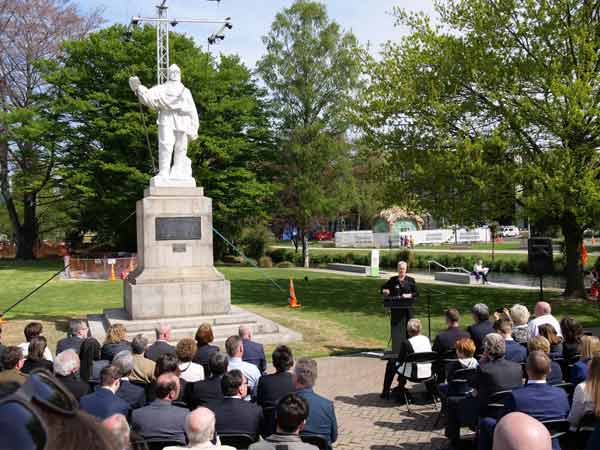Reinstatement of the Robert Falcon Scott Statue
|
As of 6 October 2017, people in Christchurch are once again able to see Robert Falcon Scott...or at least his statue, which was toppled from its plinth by the February 2011 earthquake. When the statue hit the soft ground, it broke apart at its weakest point...Scott's legs at the ankles. | ||
 The 5500-pound statue on the ground after the earthquake. Fortunately, the soft ground cushioned its fall. Wikimedia image by Schwede66 (Phillip Pearson) (file and license info) |
 For a 2012 ice festival, the statue was on display in Hagley Park in a glass case. Wikimedia image by Schwede66 (Phillip Pearson) (full size and license info) |
|
|
In the immediate aftermath of the quake, other priorities were more urgent. The statue had originally been commissioned by Christchurch in 1915...it was carved by Scott's widow Kathleen Scott in Carrara, Italy, using marble from that site. It was erected on the corner of Worcester Boulevard and Oxford Terrace, and dedicated on 9 February 1917.
Note that Kathleen did not quite finish the statue...the details of the gloves are unfinished, and one of the legs rests against a stump to support the figure. Kathleen offered to complete thes areas when she returned to Christchurch, but this never happened (Wikipedia reference).The original statue featured Scott holding a bronze pole...which has not yet been restored or replaced in the above image. Serious attention was turned to the restoration of this statue in early 2016, after repairs to other statues had been completed...and after other options, such as displaying the unrepaired statue and constructing an entirely new memorial, were considered. The issues included not only displaying an accurately restored and strengthened statue, but also meeting building code safety requirements. Meanwhile, in January 2016, the statue was temporarily displayed in the Canterbury Museum's "Quake City" exhibition in the Re:Start Mall (Canterbury Museum page). And, a scheme was developed to use four carbon fiber rods drilled into each leg from waist to foot. These were woven together with carbon fiber strands and fixed with adhesive. This technique was tested by creating a replica leg from the same Carrara marble The plinth was reinforced by drilling and epoxy grouting stainless steel rods. And the statue was attached to the plinth using a heavy steel spring to provide base isolation and allow flexibility during future earthquakes. The statue was lowered head first and packed in compacted sand to support it while the legs were being drilled out. Here is a June 2017 Christchurch City Council report which includes a brief video of the statue being embedded in sand. And here is their PDF with more details and photos of the restoration. The restored statue was unveiled in the 6 October ceremony depicted in the above photo by Anthony Powell. At the podium is ChloŽ Dear, a deputy director at The Antarctic Office (an organization set up in 2017 by the Christchurch City Council to support and foster Antarctic-related activity). The ceremony is also described and depicted in this Christchurch Press article with video. The intent of the restoration was to have the statue unveiled before he annual wreath-laying ceremony marking the start of the main Antarctic season--this tradition started by RADM Richard E. Byrd in the 1930s. The wreath-laying was scheduled for Sunday 8 October. | ||


